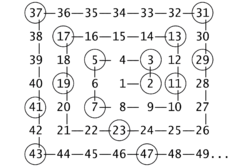This article includes a list of references, related reading, or external links, but its sources remain unclear because it lacks inline citations .(January 2019) |




In geometry, a spirangle is a spiral polygonal chain. Spirangles are similar to spirals in that they expand from a center point as they grow larger, but they are made out of straight line segments, instead of curves. Spirangle vectographs are used in vision therapy to promote stereopsis and help resolve problems with hand–eye coordination.
